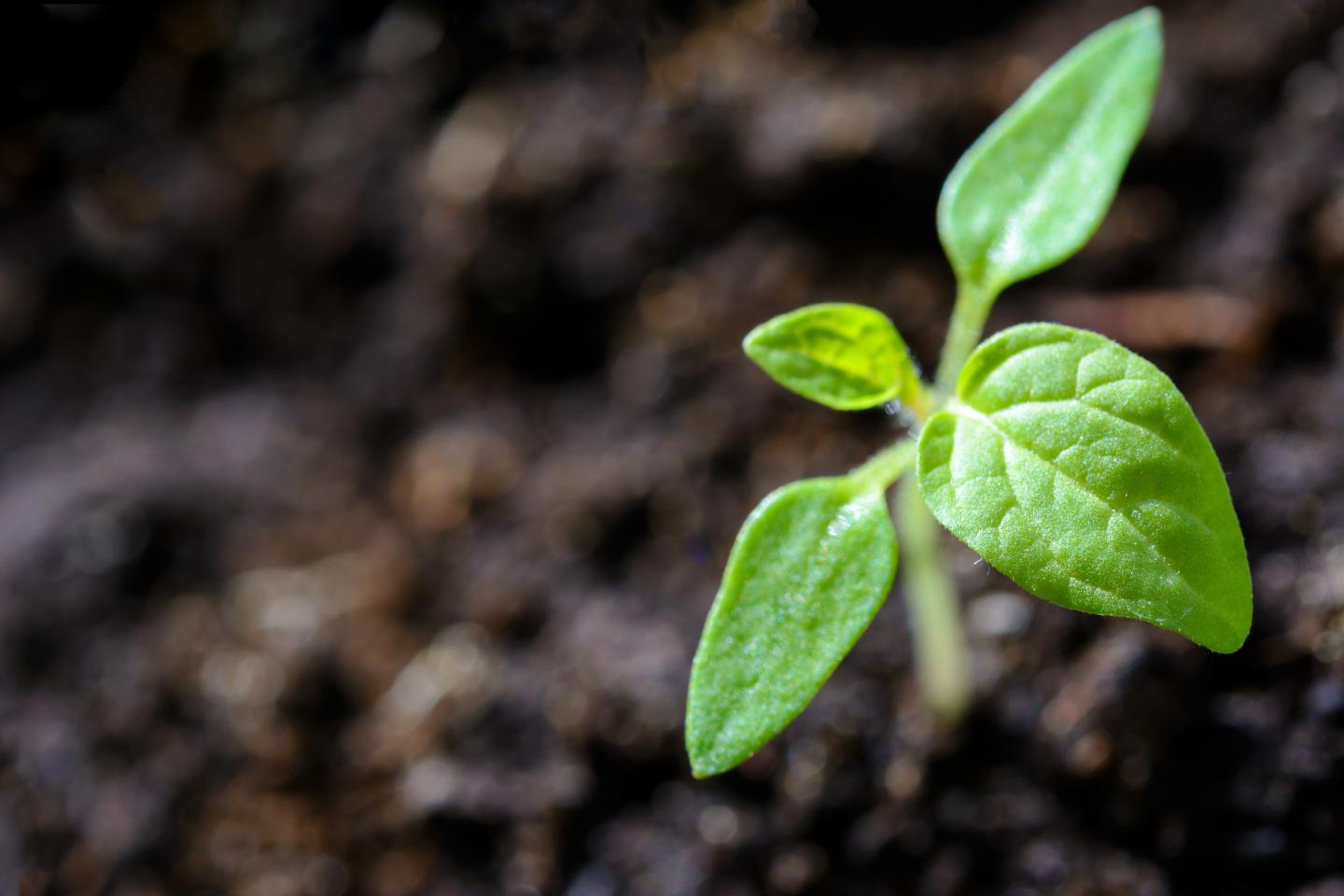Plants use a single communication route when developing new chloroplasts

Credit: Image by PhotoMIX Ltd. No copyright. No credit required.
https://www.pexels.com/photo/closeup-photo-of-sprout-1002703/
Researchers in Japan and the U.K. have discovered new details of how young leaves build their first chloroplasts, the energy factories of plant cells. The researchers identified a new role for a protein that was first identified 25 years ago, but had defied characterization until now.
When a new plant germinates from a seed and begins growing its first leaves, it is in a race of survival to build its chloroplasts. Without chloroplasts to convert sunlight into energy, that life-giving sunlight instead burns the plant from the inside out by producing harmful chemicals called reactive oxygen species. Building the chloroplasts requires a relay of communication signals between the developing chloroplast and the plant cell’s central DNA center, the nucleus.
The protein that the researchers characterized, GUN1, was known to have an important role in this communication between chloroplast and nucleus, but the details of its role remained unclear.
“GUN1 has been a mystery for such a long time,” said Professor Tatsuru Masuda from the University of Tokyo, leader of the ongoing research and final author of the recent publication in the Proceedings of the National Academy of Sciences.
GUN1 was previously difficult to study because, although plant cells make more of it throughout their lives, the protein is quickly degraded under sunlight.
The research team revealed that GUN1 influences the production and release of another proposed communication molecule.
During the first days of leaf development and times without sunlight, GUN1 binds to an iron-containing molecule recently made famous by the alternative or plant-based “meat” industry: plant heme.
Plant heme is part of a class of chemical compounds called tetrapyrroles, large molecules built from four pentagon rings that tether metal atoms in their center, like iron (heme) or magnesium (chlorophyll). Tetrapyrroles are an ancient class of molecules essential for life in most organisms. Although researchers understand how tetrapyrroles are built, little is known about how they move around the cell and what they do on their journeys.
In a series of experiments using GUN1 isolated from young plant leaves, researchers observed that the protein binds directly to heme and other tetrapyrroles, thereby controlling the cell’s production of heme.
“We propose that GUN1 binds to heme to block it from moving from the chloroplast to the nucleus, which may help ensure that chloroplasts develop efficiently,” said Masuda
Since GUN1 is degraded in the presence of sunlight, it only releases heme to send a signal to the nucleus while there is light available for the chloroplasts to photosynthesize into energy.
“Understanding how chloroplasts are built naturally may one day allow us to potentially manipulate how plants perform photosynthesis in unfavorable conditions, like under very high- or very low-intensity light,” said Masuda.
GUN1 is part of a group of six gene mutations that all affect how the chloroplast and nuclear genomes communicate. The other GUN proteins also interact with other types of tetrapyrrole molecules. Researchers hope that now having characterized all the GUN proteins will lead to a more detailed understanding of how tetrapyrroles contribute to communication from the chloroplast to the nucleus.
“Our next steps will be to pinpoint exactly where along the protein GUN1 binds to heme or other tetrapyrroles, and continue to track heme transport around the cell,” said Masuda.
###
Research Paper
Takayuki Shimizu, Sylwia M. Kacprzak, Nobuyoshi Mochizuki, Akira Nagatani, Satoru Watanabe, Tomohiro Shimada, Kan Tanaka, Yuuki Hayashi, Munehito Arai, Dario Leister, Haruko Okamoto, Matthew J. Terry, & Tatsuru Masuda. 15 Nov 2019. The retrograde signaling protein GUN1 regulates tetrapyrrole biosynthesis. Proceedings of the National Academy of Sciences of the United States of America. DOI: 10.1073/pnas.1911251116.
Related Links
Masuda Laboratory of Plant Metabolic System: http://webpark1435.
Graduate School of Arts and Sciences: http://www.
Research contact
Professor Tatsuru Masuda
Department of General Systems Studies, Graduate School of Arts and Sciences, The University of Tokyo, 3-8-1 Komaba, Meguro-ku, Tokyo, 153-8902 JAPAN
Tel: +81-(0)90-6653-9977
E-mail: [email protected]
Press Contact
Ms. Caitlin Devor
Division for Strategic Public Relations, The University of Tokyo, 7-3-1 Hongo, Bunkyo-ku, Tokyo 113-8654, JAPAN
Tel: +81-(0)3-5841-0876
Email: [email protected]
About the University of Tokyo
The University of Tokyo is Japan’s leading university and one of the world’s top research universities. The vast research output of some 6,000 researchers is published in the world’s top journals across the arts and sciences. Our vibrant student body of around 15,000 undergraduate and 15,000 graduate students includes over 4,000 international students. Find out more at http://www.
Funders
Japan Society for the Promotion of Science, Institute for Fermentation Osaka, Gatsby Charitable Foundation, UK Biotechnology and Biological Sciences Research Council, Deutsche Forschungsgemeinschaft.
Grants
JSPS KAKENHI grant numbers JP16K07393, JP18H03941, JP19H02521, JP18K05386, JP18K14650 and JP17K07444. M.A. was supported by the Institute for Fermentation, Osaka. S.M.K. was supported by the Gatsby Charitable Foundation. Work on retrograde signalling by M.J.T. is supported by the UK Biotechnology and Biological Sciences Research Council. D.L. is supported by the Deutsche Forschungsgemeinschaft (SFB-TR175, project C05).
Media Contact
Professor Tatsuru Masuda
[email protected]
81-090-665-39977
Original Source
https:/
Related Journal Article
http://dx.




